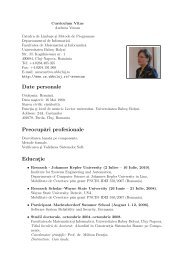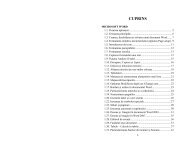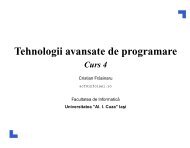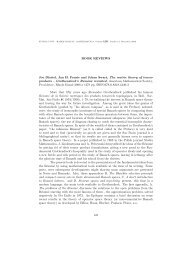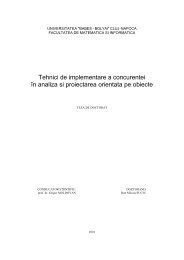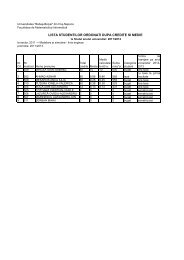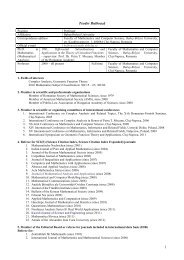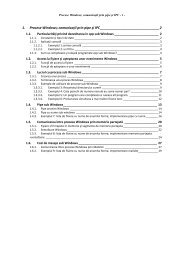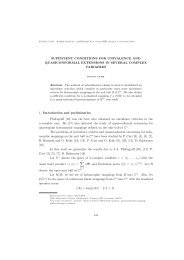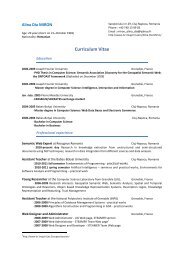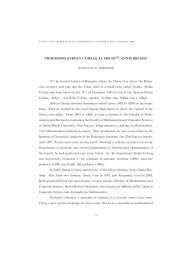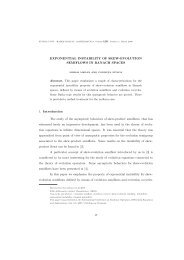CONTENTS
CONTENTS
CONTENTS
Create successful ePaper yourself
Turn your PDF publications into a flip-book with our unique Google optimized e-Paper software.
ALGEBRAIC MODEL FOR THE SYNCHRONOUS SR-FLIP-FLOP BEHAVIOUR 237<br />
3.2. The case of synchronous SR flip-flop. From the structural point of view,<br />
in order to obtain the synchronous SR flip-flop we consider the asynchronous circuit<br />
and we add an extra level of AND gates for involving the clock signal.<br />
We consider two levels for specifying the synchronous SR flip-flop behaviour, a<br />
specification and an implementation, and we conclude with the equivalence result for<br />
these models.<br />
We propose the higher-level specification for the synchronous SR flip-flop behaviour<br />
based on the agents:<br />
(3) SpecSRs(m, n, c) = (SpecInput(c) × SpecSR(m, n)) ↾ E SRmn(c)<br />
where the set of external actions is E SRmn(c) = {CLKc, σ, ρ, γ, δ} for a specific<br />
value of c ∈ {0, 1}. Note that the parameters m and n have complemented values, by<br />
definition of the flip-flop.<br />
We also propose the lower-level specification for the synchronous SR flip-flop<br />
behaviour based on the agents:<br />
(4) ImpSRs(m, n, c) = (ImpInput(c) × ImpSR(m, n)) ↾ E SRmn(c)<br />
It is for the interest of this paper results to prove the next equivalence.<br />
Proposition 1. The previous agents SpecSRs(m, n, c) and ImpSRs(m, n, c) for (m, n) ∈<br />
{(0, 1), (1, 0)} and c ∈ {0, 1} are bisimulation equivalent.<br />
The previous agents SpecSRs(m, n, c) and ImpSRs(m, n, c) are defined for all of<br />
the binary combinations on the input lines S and R of the flip-flop. In order to extend<br />
the algebraic model of the flip-flops behaviour to the algebraic model of the more complex<br />
sequential logic circuits based on flip-flops, it is useful to have the projection of<br />
such an agent on only one input binary combination (S, R). For achieving this target,<br />
we have to project each of the generic agents SpecSRs(m, n, c) and ImpSRs(m, n, c) on<br />
each of the binary combinations (S, R) ∈ {(0, 0), (0, 1), (1, 0), (1, 1)}. The final agents<br />
are SpecCBBSRs(m, n, S, R, c) and ImpCBBSRs(m, n, S, R, c) for each current state<br />
(m, n), input binary combination (S, R) and clock signal c. These agents are also<br />
bisimulation equivalent.<br />
3.3. Automatic verification. In order to have an automatic verification for the<br />
bisimilarities between the corresponding specification and implementation agents already<br />
defined in the previous subsections, we have developed the SCCS files with<br />
respect to the CWB-NC platform syntax. For each of the Spec-Impl pair of agents,<br />
we have verified the appropriate bisimilarity. The corresponding CWB-NC answer is<br />
TRUE for all of these tests. We have also obtained successfull CWB-NC automatic<br />
verification for the corresponding implementation agents and for the bisimilarities<br />
tests.<br />
4. Conclusions<br />
Based on ideas from [3, 5], in this paper we have considered the internal structure<br />
of specific memory cells, namely SR flip-flops. As original contribution we have<br />
defined specific agents for modelling the concrete flip-flops behaviour for both the



